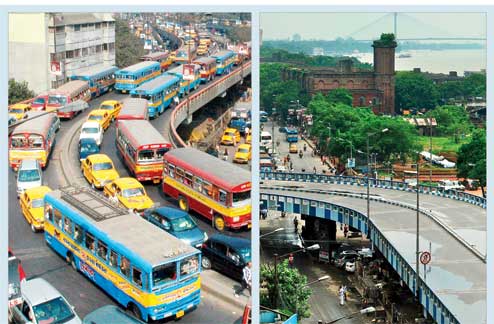March 1: Satellite imagery has revealed how water bodies in a portion of the East Calcutta Wetlands close to the Bypass have shrunk by 77 per cent in 14 years despite protective legislation and the status of a Ramsar site.
Bhagabanpur Mouza, which in 2002 was 88 per cent water body, became 80 per cent land by 2016, according to a study by the Society for Creative Opportunities and Participatory Ecosystems.
This highly damaged portion of the East Calcutta Wetlands starts barely 4km from the Bypass, behind Ruby General Hospital, and adjoins Ward 108 of the Calcutta Municipal Corporation. Bhagabanpur is one of the largest mouzas of the wetland belt and constitutes about 5 per cent of the total area.
In 2002, when the East Calcutta Wetlands became part of the inter-governmental agreement on wetland protection called the Ramsar Convention, Bhagabanpur comprised mostly wetlands and ponds spread over 580 acres.
Barely 70 acres of this area was land. In the 14 years since, land sharks have rampantly filled water bodies to create a 464-acre cluster of habitation that is reflected in census figures.
A comparison of census data from 2001 and 2011 shows a four-fold increase in the number of houses in the area and population density. "Since the last census, the scale of violations has been even greater," said ecologist Dhrubajyoti Ghosh, who anchored the study.
Ghosh has been at the forefront of the campaign to save the East Calcutta Wetlands, which many refer to as the city's kidneys because of its unique ecosystem that naturally treats 250 million litres of sewage every day. The treated waste in turn benefits agriculture and fisheries.

Demand for judicial commission
March 1: Green activists today demanded a judicial commission headed by a Supreme Court or high court judge to probe the destruction of water bodies within the East Calcutta Wetlands. The resolution titled “Save and Sustain East Calcutta Wetlands” was initiated by the NGO Sabuj Mancha and supported by environmental crusaders like Dhrubajyoti Ghosh, who had anchored the campaign to get the wetlands recognised as a Ramsar site.
“Encroachments on the wetlands started during the Left era and have continued under Trinamul,” Naba Dutta, secretary of Sabuj Mancha, said.
Environmental activist Subhas Datta said approaching the courts to save the wetlands would be the only way out “if the government does not take heed”.
"Our analysis shows that 37 out of 47 large bheries (water bodies where fish are reared) in Bhagabanpur Mouza have been filled between 1996 and 2016," said Dhruba Dasgupta, a researcher associated with the study. "The process of converting water bodies into landmass has quickened over the past decade. In 2006, water constituted 57 per cent of the area, which is now down to 20 per cent."
The study, which included field verification, picks 2006 as a benchmark year for comparison because that was when the state government created a management authority for the wetlands. "The idea is to try and understand the scale of violation in spite of restrictions being in place," said a researcher.
The change in land-use pattern across Bhagabanpur Mouza shows the destruction of water bodies. "Analysis of the available data shows that the settlement area increased from 0.18 per cent in 2002 to 13.2 per cent in 2016. It is clear that water bodies have been filled for habitation," the researcher said.
A resident of the area said political patronage of the land mafia started during Left rule and increased in recent years. "Bhagabanpur is a 15-minute drive from the Bypass, which means demand for land is high. Plots are now sold at up to Rs 14 lakh a cottah."
The middle-aged man, who declined to be named, fears the remaining water bodies will vanish once mutation of land is allowed.
Environment minister and mayor Sovan Chatterjee, who took over as chairperson of the East Calcutta Wetlands Authority last week, has said people living in the wetland belt would soon be granted mutation rights.

